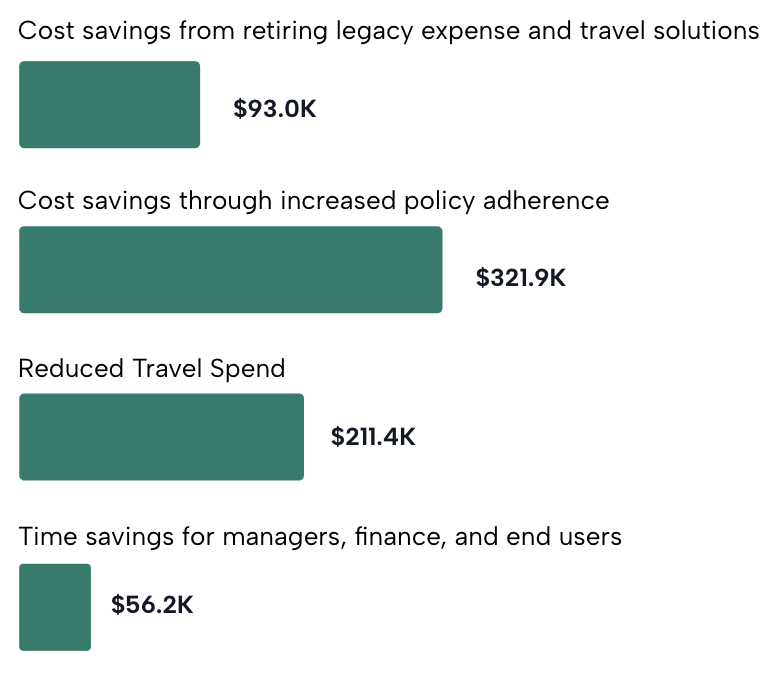The Most Common Challenges of T&E Management
Travel and expense (T&E) spending is significant at many organizations, and difficult to rein in. Organizations often rely on a patchwork of antiquated T&E management tools (or homegrown spreadsheets). But they’re inefficient and lead to overspending, especially on travel. If you’re in a similar position, chances are you’re struggling with these T&E management challenges.
Lack of Visibility into T&E Spending
For organizations using homegrown spreadsheet solutions, T&E management is an inefficient process that requires significant time to manage approvals, reporting, and reimbursements. Staff are often in a rush to perform their tasks and don’t have the bandwidth to evaluate expenses and catch policy infractions.
Similarly, most legacy platforms make it difficult to pull reports, and don’t automatically flag policy infringements.
In a 2024 commissioned Forrester Consulting Total Economic Impact™ study, one customer of a legacy platform said, “We had no control… basically, we were in a rush to process. We didn’t have time to take a look and evaluate all of the expenses and where the money was going.” And another shared, “We realized we needed to get our arms around the expense to understand the spending and where it was going. We had leadership that didn’t realize how much we were spending.”

Low Adherence to T&E Policies
Organizations frequently set T&E policies but have no way to encourage or enforce adherence. And some tools or processes are so slow and cumbersome, employees simply forgo formal channels and book directly with vendors.
When booking on their own, employees frequently choose their preferred providers to maximize individual perks, such as airline miles or hotel points. This leads to missed opportunities, such as employees not leveraging company-preferred discounts.
>> Related: Why Orgs Consistently Struggle with T&E Policy Adherence <<
In the same study, a director of ERP solutions at a healthcare organization described a common scenario: “Travel for us was a free-for-all situation… People booked at a premium and chose carriers based on their personal preference or personal rewards, not on price. We knew there was extra spending we were not catching… [And] if someone booked out-of-policy we might find out, we might not. It might have taken me two or three months to catch.”
But adherence is probably the most important part of T&E management. In Forrester’s study, they modeled that improving policy compliance nets the greatest financial benefit:

High Cost of Legacy Solutions
Many expense management platforms lack travel-specific functionality and support, requiring organizations to contract with multiple providers at additional cost. Not to mention the headaches of dealing with procurement, invoicing, implementation, reconciliation, reporting, and ongoing training, which can all double without an integrated system.
Forrester interviewees consistently expressed frustration with the high subscription costs of patchwork solutions, which often included additional surcharges, such as charges per report, or charges for unnecessary functionality.
Poor User Experience
In a golden age of consumer apps and UX, legacy T&E tools frustrate users:
- Employees want a quick and streamlined process to submit expenses, and save time all month. Instead of hoarding receipts until the end of the month and submitting one large report, users want to scan and submit expenses in real time on their phones.
- Managers want an elegant and mobile-friendly interface for reviewing and approving expense reports. They want to provide comments directly within reports, and get alerted by out-of-policy spend.
- Travelers want peace of mind while they travel, with live support available via phone, chat, online messaging platforms, or email.
Instead, employees are saddled with clunky and labor-intensive processes. The director of ERP solutions at a healthcare company described: “The previous platform was very challenging and very difficult to use. The expense functionality was antiquated. The platform was like a dinosaur.”
>> Related: Is a Travel Support Chatbot Enough? <<
Inefficient T&E Process for Employees and Management
In combination, these challenges contribute to an inefficient process for both end users and management:
- Employees struggle with poor user experience, lack of real-time support, and cumbersome processes.
- Management lacks visibility into spending and policy adherence.
- Accounting struggles with manual and limited reporting capabilities, often performing manual calculations in separate spreadsheets.
- And on all fronts, users invest significant effort while underachieving organizational needs.
The burden can be exponential across a large organization or large expense report volumes. Forrester’s study modeled that making mundane tasks like approving requests, submitting expenses and receipts, and creating reports just 15% more efficient, would save $56,000 over 3 years. What could you save?



